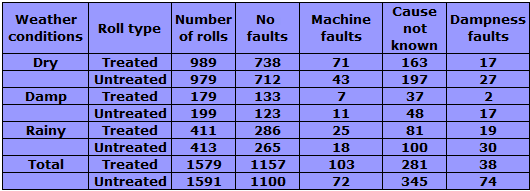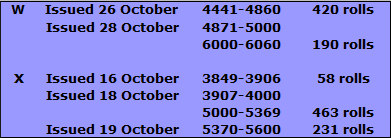Over the years a regular problem was of stamps in Post Office stamp selling machines becoming ‘tacky’ through absorption of moisture from the atmosphere. The normal remedy where this was a problem was to use smaller rolls of 480 or 960 stamps, instead of 1,920, so that these were changed more quickly. If stamps in service were found to be damp, these could be withdrawn and placed in a moisture absorption unit to dry out. If this was done, it was essential that the roll was un-wound and re-wound before reinsertion to ensure that the stamps had not stuck together.
With this problem in mind, tests were carried out during 1936 at the Research Section of the Post Office Engineering Department to see if a damp-resisting lacquer or varnish could be found to assist in reducing the difficulties caused by damp. Test rolls were made using ‘dummy’ (green ‘poached egg’) stamps treated with a solution of cellulose acetate. Following the change to the black-grey dummy stamps, these were used for tests in place of the ‘poached egg’ stamps originally used. Examples of these dummy rolls were sent in October 1936 to the Government Laboratory and to the Post Office Medical Officer for testing, who, in both cases, reported that the varnish was harmless and un-obnoxious so long as the solvent was completely evaporated. The varnish was applied to the stamps with a roller, which was moistened by passing through a bath containing the varnish.
In December 1936 the decision was taken to conduct field trials over a 3 month period. About 150 rolls per week would be needed, half of these would be opened, treated to render them moisture resistant, re-rolled and resealed. The other half would also be opened and resealed to make them resemble externally the treated rolls. Each roll would have a reference number marked inside the core. The rolls selected were those coded ‘W’ (1/2d x 960) and ‘X’ (1d x 960) and the treatment would be carried out at the Research Department at Dollis Hill. Initially, treated rolls were given even numbers and untreated rolls odd numbers. No definite information has been found as to the stamps used for these trials – it is known that some King George V ‘W’ and ’X’ rolls containing photogravure stamps were treated but there is no confirmation that these were issued, and Edward VIII ‘W’ and ‘X’ rolls were available before the trials began in March and April 1937, so it seems likely only Edward VIII rolls were issued.
For the proposed later trials, George VI stamps were used but these were not issued.
The Post Office had prepared a list of machines throughout the Country which were causing problems and a number of these were selected to be used in the trials. Early in 1937 details were sent to the Head Postmaster of the areas concerned, who were instructed to replenish specified machines with stamp rolls ‘W’ and ‘X’ which would contain either treated or untreated stamps, although Postmasters were not told which type of stamp they were handling. A return was then to be made of all mechanical faults, difficulties or complaints that arose. The reference number of the roll and the date of insertion and with-drawl were to be noted. The returns were later collated and the following table shows the results up to the end of December 1937:

Because the Post Office’s own tests showed a greater advantage for treated rolls, it was felt that a number of faults attributed to treated rolls had actually been caused by the untreated roll used previously and in order to minimise this possibility of error, in future treated rolls were numbered in consecutive 5s. In addition it was pointed out that rolls were included in the appropriate fault column irrespective of the number of times the fault occurred during its life in the machine.
Whilst the original trial was underway, Harrison were asked to look into the possibility of applying the lacquer during the printing process. Trials showed there were considerable difficulties. It would not be possible to apply it during the printing or perforating operations because of the time the lacquer would take to dry. It could not be applied as a separate operation after printing as this would cause irregular expansion and contraction of the register necessary for correct perforation, nor would the web stand the application after perforation. The remaining possibility would be to apply the lacquer as a separate operation after the operation of fracturing (breaking the stiffness of the gum to prevent curling). In addition Harrison were concerned about the fire risk as the lacquer was highly inflammable and would require special facilities to be made available, but they did agree to test various alternatives treatments.
During 1938 discussions were also held with Samuel Jones & Co Ltd regarding the possibility of the treatment being carried out by them on gummed watermarked paper. Although Messrs Jones were agreeable, various delays occurred in finding suitable varnish and in the end the proposal was not proceeded with.
Tests continued using different varnishes, which were deemed to be reasonably successful and it was decided to carry out an extended trial, mainly in London and Manchester. During the latter half of 1938 Harrison produced some 5000 rolls (containing George VI stamps) for use in these extended trials. When these were sent for testing at the Government Laboratory however they found that the adhesiveness was not equal to that of untreated stamps. The Research Department also found that the stamps were too heavily coated and not recommended for use. As a result of a meeting on 14 February 1939 it was decided that the rolls would not be released, but destroyed by burning. The actual quantities of rolls involved were:

As the rolls contained stamps with different treatments it was agreed that 50 of each batch treated would be retained for reference in connection with any future experiments that might be made. On 29 April 1939 it was confirmed that 2493 ‘W’ rolls and 2614 ‘X’ rolls had been destroyed. The 200 rolls retained were:

There were no further developments and in 1943 it was reported that from the absence of complaints in recent years the problem seemed to have been dealt with by other means, and the question of lacqering unlikely to be raised again.. It was therefore suggested that the remaining rolls should be pulped, especially in view of the war-time need for paper pulp. This was agreed and on 10 April 1943 it was confirmed that this had been done.
TREATED STAMPS ISSUED FOR GENERAL USE
During the latter part of 1937 rolls of treated stamps were issued in response to ordinary requisition so that the stocks of Edward VIII rolls could be exhausted as quickly as possible. Some 610 ‘W’ rolls and 752 ‘X’ rolls containing Edward VIII stamps which had been treated, were issued during October and bore the following codes:

Although the coating was stated to be very thin, it may be possible to identify stamps used in these trials by careful examination, particularly round the perforations, although none have so far been recorded.